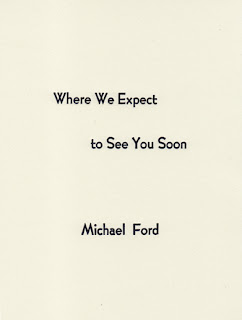This review first appeared in the literary journal Entrepôt in April, 2012.
Ugly Duckling Presse, 2011
Reviewed by Megan Burns
Often there
is a text that haunts the text you’re reading. In the case, of Michael Ford’s Where We Expect to See You Soon, the
reader is pointed in the direction of one such haunting in the opening
epigraphs. Alice Notley’s line: “we move back into a damaged city” both frames
the context of these poems and also signals to the careful reader a subtext for
this work in both rhythm and line. I say rhythm and line because I don’t think
one can bring to mind Notley at the beginning of a poem sequence without being
attuned to her attention to the way a poem moves both in its line and each line
in its place in the world of the poem. The epigraph is the first line from a
poem “City” from the unpublished collection “Benediction” in Grave of Light (Wesleyan, 2006). The
word “city” in the line though immediately reminded me of another chapbook,
entitled “City of” by Notley (Rain Taxi, 2005). The two are probably linked in
more than language as I read Notley’s chapbook after returning to New Orleans
in late 2005 with its prescient lines: “It’s a placid / earth of horror and /
from it/ I begin//No nation now/ only a/ city.” Ford, also a New Orleans poet,
touches on these same images in the opening poem “The New Atlantis” where we
find, “The city was marked— in the atlas as lost—the map of the place.” So,
here are two texts wrestling with the city, the loss of the city and the
illusion of the city. Each text also is setting down lines with precise
rhythmical markers that tell us how to read the line as though we were locating
through sound some sense of locale in the breath. Ford’s technique is to use
the dash to break up any continuity in the line and to cause the reader to stop
short and then begin anew. The line breaks become not the breaks, or smaller
breaks when confronted with the eye’s need to traverse the horizontal line
separating the sentences. In a sense, the horizon line also holds the text
together, stringing through the body of the poem like a life line thrown to the
drowning person: Here, if you can follow
the path of this, if you can hear the sound of my voice, they seem to
signal. Ford’s line breaks as well though signal distress as repeatedly the
word “city” is broken amid other words cut in two by the end of the line:
“fenc/es, to/day, dig/nity, point/ing, meta/phor. o/ver.” Things are broken;
the tempo of the line, if not for the break caused by the dashes, would hurl
forward at a rapid pace, especially as the images of what the city is pile up.
In the ways that memories of loved ones crowd forward, the city is displaced
and in its stead a cacophony of oral and aural images surface to take its
place. The narrator guides us through
the ruins: “We make our way by match light—conveyed—on/ light bones and
feathers—wings fanned out.” And that’s just the first poem.
Ford tells us in a note at the back of the book that all of
the poems are written in a form he calls “89,” where the syllable count in the
lines as well as the lines in each stanza adhere to a loose structure based on
8 and 9. This brings us to the second epigraph from Shakespeare: “And in fresh
numbers number all your graces.” This isn’t the first time that Ford has used a
number constraint to create his poems. The success lies in the all but
invisible deployment of the method. Far more obvious than the number form on
the poems is Ford’s use of the dash to break up his lines and his use of space
to cut the line cleanly and control his rhythm. Take the poem “Lizzie Borden,
What’s all the Fuss About?” which begins with the line “This will be my murder
ballad—” and then precedes to deliver a poem mimicing both Williams’ variable
foot as well as subject matter, only to break off in the next line stating:
“These fucking numbers are on every-/ thing.” In light of the author’s note,
the double meaning behind such a line is even richer. More interesting to me is
always Ford’s deft handling of the movement of the poem, here at once he is
able to slow the line down to a crawl like William’s cat foot creeping about
and then pick it back up to toss it around.
Ford also has the poet’s eye of taking a seemingly innocuous statement
and placing it down amid a sea of chaos, so it suddenly resounds loudly. Take
the line: “The river is deep because/ there is so much water in it.” Alone we
might find this statement quaint, but in Ford’s hands this is the poem “10 Most
Dangerous Places in Space” and we have been led here with this reminder: “We will
never meet—in quiet/—in footprints on another globe—We/ will never meet again.”
Another connection between Ford and Notley for me is that their poems often
chill me to the core, and yet I can’t let go of them. Ford presents us with the
familiar just enough out of place so that we can never get comfortable; his
poems envelope the terror —root in the “terra incognita.”

No comments:
Post a Comment